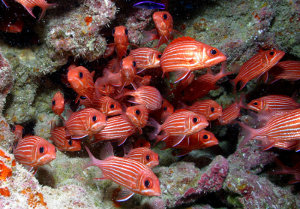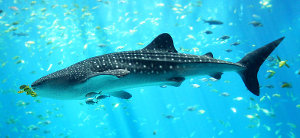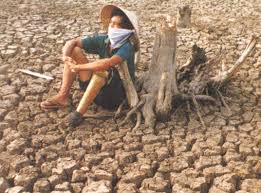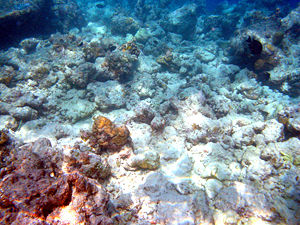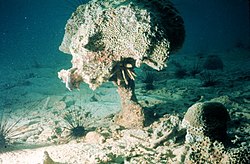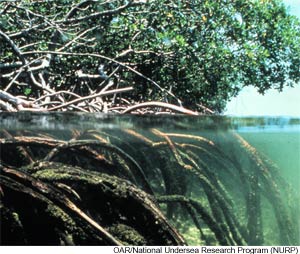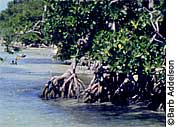Massive Extinctions From Human Activity
As well as the need for biodiversity for continued ecosystem survival (as explained in the Who Cares? section on this web site), from a human perspective, from common drugs to possible cures for cancers, most of our medicine come from plants, many of which are now endangered.
However, it has long been feared that human activity is causing massive extinctions. The previous link, to a report from Environment New Service (August 2, 1999) says that “The current extinction rate is now approaching 1,000 times the background rate and may climb to 10,000 times the background rate during the next century, if present trends continue. At this rate, one-third to two-thirds of all species of plants, animals, and other organisms would be lost during the second half of the next century, a loss that would easily equal those of past extinctions.” (Emphasis added)
A huge report known as the Millennium Ecosystem Assessment, started in 2000, was released in March 2005. Amongst many warnings for humankind, it noted that there has been (as summarized from the BBC) a substantial and largely irreversible loss in the diversity of life on Earth, with some 10-30% of the mammal, bird and amphibian species currently threatened with extinction, all due to human actions. (See this site’s section on sustainable development for more on that assessment.)
A report from the World Wide Fund for Nature (WWF) in 2006 confirmed concerns from the previous year, noting that
Already resources are depleting, with the report showing that vertebrate species populations have declined by about one-third in the 33 years from 1970 to 2003. At the same time, humanity’s Ecological Footprint—the demand people place upon the natural world—has increased to the point where the Earth is unable to keep up in the struggle to regenerate.
— Human footprint too big for nature, WWF, October 24, 2006 (Emphasis added)
The International Union for Conservation of Nature (IUCN) notes in a video that:
- 1 bird out of 8,
- 1 mammal out of 4,
- 1 conifer out of 4,
- 1 amphibian out of 3, and
- 6 marine turtles out of 7, are all threatened with extinction
In addition,
- 75% of genetic diversity of agricultural crops has been lost
- 75% of the world’s fisheries are fully or over exploited
- Up to 70% of the world’s known species risk extinction if the global temperatures rise by more than 3.5°C
- 1/3rd of reef-building corals around the world are threatened with extinction
- Every second a parcel of rainforest the size of a football field disappears
- Over 350 million people suffer from severe water scarcity
Is this the kind of world we want, it asks? After all, the short video concludes, our lives are inextricably linked with biodiversity and ultimately its protection is essential for our very survival:
Research of long term trends in the fossil record suggests that natural speed limits constrain how quickly biodiversity can rebound after waves of extinction. Hence, the rapid extinction rates mean that it could take a long time for nature to recover.
Consider the following observations and conclusions from established experts and institutions summarized by Jaan Suurkula, M.D. and chairman of Physicians and Scientists for Responsible Application of Science and Technology (PSRAST), noting the impact that global warming will have on ecosystems and biodiversity:
The world environmental situation is likely to be further aggravated by the increasingly rapid, large scale global extinction of species. It occurred in the 20th century at a rate that was a thousand times higher than the average rate during the preceding 65 million years. This is likely to destabilize various ecosystems including agricultural systems.
…In a slow extinction, various balancing mechanisms can develop. Noone knows what will be the result of this extremely rapid extinction rate. What is known, for sure, is that the world ecological system has been kept in balance through a very complex and multifaceted interaction between a huge number of species. This rapid extinction is therefore likely to precipitate collapses of ecosystems at a global scale. This is predicted to create large-scale agricultural problems, threatening food supplies to hundreds of millions of people. This ecological prediction does not take into consideration the effects of global warming which will further aggravate the situation.
Industrialized fishing has contributed importantly to mass extinction due to repeatedly failed attempts at limiting the fishing.
A new global study concludes that 90 percent of all large fishes have disappeared from the world’s oceans in the past half century, the devastating result of industrial fishing. The study, which took 10 years to complete and was published in the international journal Nature, paints a grim picture of the Earth’s current populations of such species as sharks, swordfish, tuna and marlin.
…The loss of predatory fishes is likely to cause multiple complex imbalances in marine ecology.
Another cause for extensive fish extinction is the destruction of coral reefs. This is caused by a combination of causes, including warming of oceans, damage from fishing tools and a harmful infection of coral organisms promoted by ocean pollution. It will take hundreds of thousands of years to restore what is now being destroyed in a few decades.
…According to the most comprehensive study done so far in this field, over a million species will be lost in the coming 50 years. The most important cause was found to be climate change.
…NOTE: The above presentation encompasses only the most important and burning global environmental problems. There are several additional ones, especially in the field of chemical pollution that contribute to harm the environment or upset the ecological balance.
— Jaan Suurkula, World-wide cooperation required to prevent global crisis; Part one— the problem, Physicians and Scientists for Responsible Application of Science and Technology, February 6, 2004 [Emphasis is original]
Additionally, as reported by UC Berkeley, using DNA comparisons, scientists have discovered what they have termed as an “evolutionary concept called parallelism, a situation where two organisms independently come up with the same adaptation to a particular environment.” This has an additional ramification when it comes to protecting biodiversity and endangered species. This is because in the past what we may have considered to be one species could actually be many. But, as pointed out by scientists, by putting them all in one group, it under-represents biodiversity, and these different evolutionarily species would not up getting the protection otherwise needed.
Declining amphibian populations
Amphibians are particularly sensitive to changes in the environment. Amphibians have been described as a marker species or the equivalent of “canaries of the coal mines” meaning they provide an important signal to the health of biodiversity; when they are stressed and struggling, biodiversity may be under pressure. When they are doing well, biodiversity is probably healthy.
Unfortunately, as has been feared for many years now, amphibian species are declining at an alarming rate.

The Golden Toad of Monteverde, Costa Rica was among the first casualties of amphibian declines. Formerly abundant, it was last seen in 1989. (Source: Wikipedia)
Malcom MacCallum of the Biological Sciences Program, Texas A&M University calculated that the current extinction rate of amphibians could be 211 times the background amphibian extinction rate ![]() .
.
He added that “If current estimates of amphibian species in imminent danger of extinction are included in these calculations, then the current amphibian extinction rate may range from 25,039–45,474 times the background extinction rate for amphibians. It is difficult to explain this unprecedented and accelerating rate of extinction as a natural phenomenon.” (Emphasis added)
Dwindling fish stocks
IPS reports that fish catches are expected to decline dramatically in the world’s tropical regions because of climate change. Furthermore, “in 2006, aquaculture consumed 57 percent of fish meal and 87 percent of fish oil” as industrial fisheries operating in tropical regions have been “scooping up enormous amounts of fish anchovies, herring, mackerel and other small pelagic forage fish to feed to farmed salmon or turn into animal feed or pet food.” This has resulted in higher prices for fish, hitting the poorest the most.
As Suurkula mentioned above, mass extinctions of marine life due to industrialized fishing has been a concern for many years. Yet, it rarely makes mainstream headlines. However, a report warning of marine species loss becoming a threat to the entire global fishing industry did gain media attention.
A research article in the journal, Science, warned commercial fish and seafood species may all crash by 2048.
At the current rate of loss, it is feared the oceans may never recover. Extensive coastal pollution, climate change, over-fishing and the enormously wasteful practice of deep-sea trawling are all contributing to the problem, as Inter Press Service (IPS) summarized.
As also explained on this site’s biodiversity importance section, ecosystems are incredibly productive and efficient—when there is sufficient biodiversity. Each form of life works together with the surrounding environment to help recycle waste, maintain the ecosystem, and provide services that others—including humans—use and benefit from.
For example, as Steve Palumbi of Stamford University (and one of the authors of the paper) noted, the ocean ecosystems can
- Take sewage and recycle it into nutrients;
- Scrub toxins out of the water;
- Produce food for many species, including humans
- Turns carbon dioxide into food and oxygen
With massive species loss, the report warns, at current rates, in less than 50 years, the ecosystems could reach the point of no return, where they would not be able to regenerate themselves.
Dr. Boris Worm, one of the paper’s authors, and a world leader in ocean research, commented that:
Whether we looked at tide pools or studies over the entire world’s ocean, we saw the same picture emerging. In losing species we lose the productivity and stability of entire ecosystems. I was shocked and disturbed by how consistent these trends are—beyond anything we suspected.
— Dr. Boris Worm, Losing species, Dalhousie University, November 3, 2006
“Current” is an important word, implying that while things look dire, there are solutions and it is not too late yet. The above report and the IPS article noted that protected areas show that biodiversity can be restored quickly. Unfortunately, “less than 1% of the global ocean is effectively protected right now” and “where [recovery has been observed] we see immediate economic benefits,” says Dr. Worm. Time is therefore of the essence.
In an update to the above story, 3 years later, 2009, Dr. Worm was a bit more optimistic that some fish stocks can rebound, if managed properly. But it is a tough challenge “since 80 percent of global fisheries are already fully or over-exploited.”
An example of overfishing that has a ripple-effect on the whole fish-food chain is shark hunting.
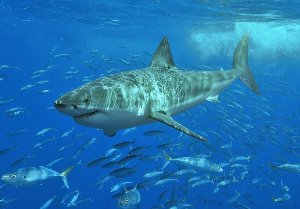
The Great White Shark is the largest predatory fish. (Source: Wikipedia)
Millions of sharks are killed each year from overfishing and trade. Many die accidentally in fishing nets set for tuna and swordfish, while others are caught for their meat or just for their fins.
A demand for shark-fin soup in places like China and Taiwan is decimating shark populations. Shark fin soup is considered a delicacy (not even a necessity) and can be extremely lucrative. So much money can be obtained just from the fin that fishermen hunting sharks will simply catch sharks and cut off their fins while they are alive, tossing the wriggling shark back into the ocean (to die, as it cannot swim without its fin). This saves a lot of room on fishing boats. Some video footage shown on documentaries such as National Geographic reveal how barbaric and wasteful this practice is.
Sharks are known as the “apex predator” of the seas. That is because in general sharks are at the top of the food chain. Without sufficient shark numbers the balance they provide to the ecosystem is threatened because nature evolved this balance through many millennia.
As WWF, the global conservation organization notes, “Contrary to popular belief, shark fins have little nutritional value and may even be harmful to your health over the long term as fins have been found to contain high levels of mercury.”
Declining Ocean Biodiversity
It is not just fish in the oceans that may be struggling, but most biodiversity in the seas. This includes mammals (e.g. whales, dolphins, polar bears), birds (e.g. penguins), and other creatures (e.g. krill).
In the past century, commercial whaling has decimated numerous whale populations, many of which have struggled to recover.
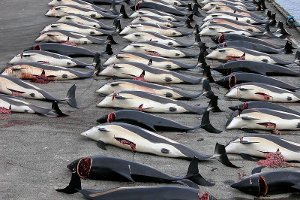
Whaling stations like this one in the Faroe Islands is also used to hold hunted dolphins and other animals. (Image source: Wikipedia)
Commercial whaling in the past was for whale oil. With no reason to use whale oil today, commercial whaling is mainly for food, while there is also some hunting for scientific research purposes.
Large scale commercialized whaling was so destructive that in 1986 a moratorium on whaling was set up by the International Whaling Commission (IWC). As early as the mid-1930s, there were international attempts to recognize the impact of whaling and try and make it more sustainable, resulting in the actual set up of the IWC in 1946. Many commercial whaling nations have been part of this moratorium but have various objections and other pressures to try and resume whaling.
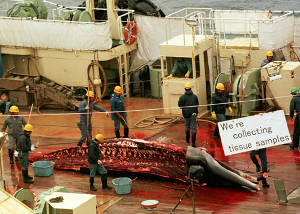
Japan often claims its whale-hunting is for scientific research; the general population are often quite skeptical of such claims. (Image source: © Greenpeace)
Japan is the prime example of hunting whales for the stated aim of scientific research while a lot of skepticism says it is for food. Greenpeace and other organizations often release findings that argue Japan’s whaling to be excessive or primarily for food, and for research as secondary.
General public negativity of commercial whaling has also led to a difference between traditional whaling communities in the arctic region and conservationists. Traditional indigenous communities have typically hunted whale in far smaller numbers commercially, mostly for local food consumption, but the impacts of large-scale commercial whaling has meant even their hunting is under pressure.
Some have argued for whale hunting as a way to sustain other marine populations. National Geographic Wild aired a program called, A Life Among Whales (broadcast June 14, 2008). It noted how a few decades ago, some fishermen campaigned for killing whales because they were apparently threatening the fish supply. A chain of events eventually came full circle and led to a loss of jobs:
- The massive reduction in the local whale population meant the killer whales in that region (that usually preyed on the younger whales) moved to other animals such as seals
- As seal numbers declined, the killer whales targeted otters
- As otter numbers were decimated, the urchins and other targets of otters flourished
- These decimated the kelp forests where many fish larvae grew in relative protection
- The exposed fish larvae were easy pickings for a variety of sea life
- Fishermen’s livelihoods were destroyed.
This may be a vivid example of humans interfering and altering the balance of ecosystems and misunderstanding the importance of biodiversity.
Dr. Sylvia Earle, described as a “Living Legend” by the US Library of Congress, is a world-renowned oceanographer, explorer, author, and lecturer. In the early 1990s she was the Chief Scientist of the National Oceanographic and Atmospheric Administration in the US. In 2009 she won the prestigious TED prize. As part of the prize, she was able to share a wish, which captured some major concerns about dwindling ocean biodiversity and its importance to all life on earth:
reference:
http://www.globalissues.org/article/171/loss-of-biodiversity-and-extinctions
